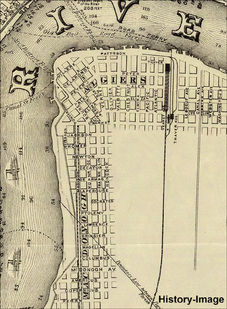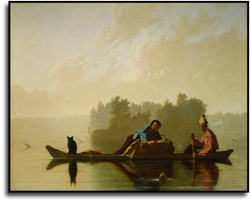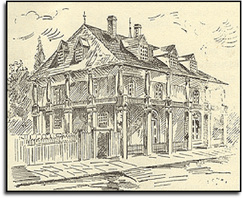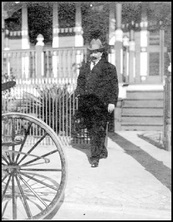The History of Algiers
New Orleans' "Red-headed stepsister"Many people feel that Algiers has always been regarded as the "red-headed step-sister" of New Orleans. During its independence from 1840 to 1870, Algiers was governed by a Police Jury but was annexed to the City in 1870, a move that still has its opponents to this day!
New Orleans' second oldest neighborhoodAlgiers was established in 1719, making it the second oldest neighborhood in the City. Originally owned by BIENVILLE as part of the "King’s Plantation," that stretched from Plaquemines to Donaldsonville and then to Natchez. It would be the site of the pens that held the enslaved Africans, that were rested, cleaned up, and ferried across the river to the French Quarter, where they would be sold into a lifetime of slavery either locally or up and down the length of the river to the new French landowners. Algiers was also the site of the City’s powder magazine, for which Powder Street was named, and the City’s slaughterhouse, and was called Slaughterhouse Point in its early history.
|
Algiers is not just Algiers Point. It stretches along 12 miles of riverfront from the Riverview neighborhood at the Jefferson Parish line to the Cut Off at the Plaquemines Parish line with a depth of about 4 miles. This land was originally cypress swamp with prairie lands to its rear. Algiers was developed from a community of hamlets with such names as Duverjeville, Mossyville, Olivierville, Gosselinville, Belleville, Brooklynville, McDonoghville, LeBeoufville, Hendeeville, Sumnerville, Leesville, Tunisbourg, McLellanville, Cut Off, Aurora, Stanton, Plaisanceville, Silver City and Oakdale.
Early Land OwnersThe land was cleared and plantation homes built along the riverfront. When the Spanish arrived in 1769, they sold off the lands in Algiers belonging to the Crown and aided homesteaders to establish farms and develop the West Bank. The two most famous of these early landowners were Barthelemy DUVERJE, whose land would be divided into lots in the 1840s to form what we now know as Algiers Point, and John McDONOGH, whose home was on Adams Street between Newton and Homer Streets. McDONOGH’s home, called "Monplaisir," and several other buildings throughout the history of Algiers, slipped into the river when landslides, or crevasses, occurred.
Since those early days, the levee system built by the Corps of Engineers, protects the residents from such occurrences today. Although McDONOGH owned much of what is now McDonoghville, he did actually live in Algiers, where he had a brick kiln and extensive pleasure gardens, where music could often be heard and dancing was THE social event of the time. |
The Original SettlersThe First Settlers were the French, and later the Spanish, who cleared the land with the help of the slaves. Later immigrant groups were "les Americains" from the eastern seaboard after the 1803 Louisiana Purchase. Then came the Germans, the Irish, the Italians and Sicilians, and other smaller European groups of immigrants. Before 1803, Catholicism was the only acceptable religion in Louisiana but after that date, Algiers, and the rest of Louisiana, were infiltrated by Methodists, Lutherans, Episcopalians and Baptists.
Algiers was built up along the riverfront from 1819, with large shipbuilding and ship repair interests. Dry docks, saw mills, lumber yards and an iron foundry added to the commercial corridor on the river. Most of the inhabitants in the mid-19th century had occupations related to ship building. Early commercial interests in Algiers included lumber, wax and sugar. The Lower Coast continued with a history of truck farms, citrus groves, dairies and plantations into the early part of the 20th century. Before all of this, though, Algiers had a Native American population whose encampment was situated on what is now Opelousas Avenue. The Cajuns came to Louisiana in 1785, were rested in a warehouse in Algiers where they were supplied with seed and tools before heading upstream to their land grants, given to them by the Spanish. The War of 1812The war saw the American troops beaten by the British in Algiers in 1815 but the British did not have as much luck on the East Bank in the fields of Chalmette where they suffered high losses and defeat.
1852 The railroad arrivesThe Railroad arrived in Algiers and later brought jobs for many, employing up to 4000 men at one time. The yards stretched from the river back 22 blocks and they could build anything from a spring to a locomotive. A ferry for the railroad trains connected the East Bank to the West Bank and onward to the Pacific
Coast.
Machine shops, storage facilities, paint shops, lumberyards, coal and oil depots, and stockyards covered the fields that are now being developed for housing. There was even a hotel on the site. Algiers gradually expanded and it is said there was a grocery store or bar on almost every corner. In 1911 Algiers could boast 39 bars! Algerines could purchase almost everything they needed without crossing the river. |
Historical Timeline1719 - Algiers Point established
1815 - McDonoghville established 1827 - Ferry began operating between French Quarter and Algiers Point 1836 - Mechanicksham established 1838 - Ferry began operating between Lafayette and Mechanicksham 1842 - David Crockett Steam Fire Company No. 1 founded. It is the oldest, continuously active, volunteer fire department in the U.S. 1853 - Algiers railroad yards established 1870 - Algiers annexed to the City of New Orleans 1895 - Great fire of Algiers; 250 homes destroyed 1911 - Thirty-nine bars in Algiers 1931 - Martin Behrman High School at 715 Opelousas Ave. opened. Until then, students from Algiers had to cross the ferry to new Orleans to attend high school. 1935 - Huey P. Long Bridge opened 1950 - Algiers Population = 27,000 1952 - Mississippi River Bridge Authority established 1958 - Greater New Orleans Bridge opened (later the Crescent City Connection). 1970 - Algiers Population 52,500 1978 - Algiers Point Historic District established 1985 - Mechanicksham-Gretna Historic District established 1988 - Second Span of Greater New Orleans Bridge opens 1989 - Crescent City Connection established 1989 - Crescent City Connection is the first US toll facility to begin using electronic toll collection. 2004 - Jazz Walk Hall of Fame opened 2005 - Hurricane Katrina; ferry hours reduced 2007 - Ferry hours restored in July 2009 - Gretna Ferry rerouted from Jackson to Canal St. Landing |
The Civil War: New Orleans falls to Union Troops
The dry docks in Algiers were scuttled and set on fire before they fell into enemy hands. The goods in the Algiers warehouses were set on fire. Large numbers
of Union troops were encamped in Algiers during the war, guarding the railroad from Algiers to Morgan City. The freed slaves would establish communities along and off of Saux Lane, the Cut Off and the upriver side of Opelousas Avenue into McDonoghville and Freetown. The Belleville Iron Foundry was used by the Union forces as a prison for Confederates; it was also used by the Confederacy to house Union prisoners before the Federal occupation of New Orleans.
of Union troops were encamped in Algiers during the war, guarding the railroad from Algiers to Morgan City. The freed slaves would establish communities along and off of Saux Lane, the Cut Off and the upriver side of Opelousas Avenue into McDonoghville and Freetown. The Belleville Iron Foundry was used by the Union forces as a prison for Confederates; it was also used by the Confederacy to house Union prisoners before the Federal occupation of New Orleans.
Voodoo & HoodooVoodoo and Hoodoo have always been present in Algiers due to the African and Haitian influences. Voodoo is a mixture of
African and Catholic religions and the local papers tell of several instances of graves being robbed of bones during the Civil War and Voodoo ceremonies in Algiers. In his "History of Algiers," William SEYMOUR mentions such ceremonies taking place on the site where the Holy Name of Mary Church would later be built. Hoodoo is the casting of spells, or conjuring. Thought by some to be a ruse for con artists, it blossomed in the early to mid-20th century. Several recordings by Blues artists mention the Voodoo and Hoodoo of Algiers. |
John McDonogh establishes FreetownJohn McDonogh established Freetown for freed slaves and other free people of color long before his death in 1850. He was buried in McDONOGH cemetery and his remains were later exhumed and returned to Baltimore, the town of his birth. Money left in his will would establish a public school system in New Orleans, and in Baltimore. Unfortunately, the lawyers took a large portion of the money he left.
The Naval StationThe coming of the Naval Station in 1848 would provide more jobs for locals. Work started in earnest in 1894
when large tracts of land were bought up and the Public Road access along the river was eventually cut off. The Naval Station would come into its own during the WW II. Today ithe property has become Federal City. The Great Fire of AlgiersThe Great Fire in 1895, destroyed approximately 200 homes and businesses including the Duverje Plantation house, then being used as the Courthouse. It would be long though before new homes were built in their place. As mentioned earlier, the plantations on the Lower Coast were subdivided and many Algerines chose to leave the area around the Point for new homes off of General Meyer and General DeGaulle, and later in Walnut Bend, Aurora, Stanton, and English Turn.
The railroad closes downThe Railroad would eventually close down in Algiers in the 1970s and when combined with the oil bust in the 1980s, would throw many men into unemployment Algiers suffered. People moved away. Businesses closed and the once charming homes would fall into disrepair. But, in the late 1980s and early 1990s, Algiers would rise like a phoenix with home buyers realizing that Algiers Point was New Orleans’ "best kept secret" with plenty of wonderful old buildings ready for renovation. Algiers Point is now one of the most sought after areas of the City to live in and has a wonderful community atmosphere. It is close to the French Quarter without all the madness that goes with it.
FerriesFerries had been in existence in Algiers since 1827, and the Huey P. Long Bridge was built in Jefferson parish in 1937. The first bridge in Orleans parish crossing the river was built in 1958, linking the East and West Banks. A second bridge was added in 1988. Both these bridges cut through African American neighborhoods, destroying homes and communities. The Oakdale community was destroyed when the Fischer housing project was built. Now, that too has been torn down to build new homes. Algiers Point can still boast homes that date back to before the Civil War.
EntertainmentEntertainment was always important to Algerines. Theatres such as Philip FOTO’s Market Theatre and the Folly Theatre provided vaudeville, silent movies and music. Dances were held at the Elmira Pleasure Grounds, the Avenue Dance Academy, the old and new Masonic Halls, the Knights of Columbus Home, the Knights of Pythias Hall, the Varsity Club, and Behrman Gym, to name a few.
Martin BehrmanThis four times Mayor of New Orleans, resided on Pelican Avenue and is said to have run the City from his front room with the help of several other Algerines. Born in New York City in 1864, he was about seven months old when his parents moved to New Orleans. They died when he was young and he worked
in the retail trade and later got into politics. He was much loved by his constituents and when he died in 1926, 20,000 people filed past his funeral bier. |




